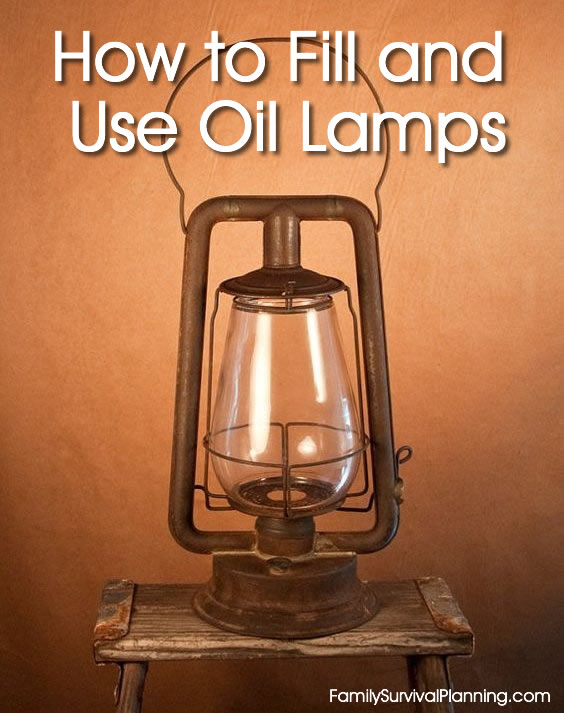- HOME
- Survival Gear
- Oil Lamps
Oil Lamps For Warmth and Light
How to Fill and Use Oil Lamps
When the power goes out due to a storm, disaster, or power company issue, it's comforting to have several methods of providing light when evening comes.
Candles and flashlights are very useful, but an oil lamp will burn from 60-120 hours, allowing your family to play games or read to take your minds off that TV show you know you're missing.
You may not think there's much to learn about filling and using an oil lamp, but there are some little tips and tricks to make the job easy. It's not like flipping a light switch. It isn't difficult but, done correctly, it will become second nature to you.
Invest in emergency food storage now and enjoy peace of mind for the next 25 years. Don't miss out on the savings!
What Type of Oil Should I Use?
Many people advocate using vegetable oils in oil lamps. If you don't mind the "off" smell, these types of oil can be used. (Using a few drops of your favorite essential oil will help disguise the smell.)
If you have stored a lot of vegetable oil and it goes rancid, it would be better to burn it in your lamp than consume it. Rancid oil can be very detrimental to your health — like poison.
However, I must caution you never to use gasoline, alcohol or camp stove fuel in an oil lamp. They are too volatile and burn dirty. By the way, the so-called "odorless" lamp oils are not completely odorless, but if you had to use your oil lamp for days, you would probably get used to the smell.
Lamp Oil is Best
Lamp oil is in the same family as kerosene, but it has been purified to make it burn cleaner, so the burning of lamp oil produces fewer pollutants than burning kerosene.
It doesn't produce the unpleasant odors of burning kerosene and can even be purchased in a variety of scents. Lamp oil can be purchased in most supermarkets, home improvement and, hardware stores, but it is more expensive than kerosene. It also does not burn as brightly as kerosene.
Lamp oil is always safe to burn indoors without venting to the outside. You should always use the specific kind of fuel recommended for your lamp.
These fuels are approved for indoor or outdoor use in lanterns and oil lamps:
Storing Lamp Oil
When storing lamp oil, be aware that it can actually freeze below 20 degrees. It's best to have your oil at room temperature before filling the lamp. Cold oil burns a bit faster than oil at room temperature — oil will burn about 1/2 ounce per hour.
That means a half gallon of oil will last approximately 140-150 hours. (Vegetable oils will last slightly less.)
If lamp oil comes in a plastic container, it's best to transfer it to a glass or metal container for long term storage. The plastic containers become brittle after a while and can be easily broken or punctured.
How to Assemble Your Oil Lamp
- Remove the glass chimney and unscrew the burner assembly.
- Pour in lamp oil. Do not overfill. The lamp oil level should be at least half an inch below the reservoir lip.
- Thread the wick into the burner assembly.
- Screw the burner assembly back onto the base and allow the wick to become completely saturated with lamp oil.
How to Light Your Oil Lamp
- Turn the wick up until it is just high enough over the brass lip to light easily, approximately one-fourth of an inch.
- After lighting, turn the wick back down to level with or barely below the brass lip.
- Replace the glass chimney on the burner so it fits tightly inside the chimney bracket. You then can adjust the wick slightly up or down to achieve the desired brightness. Generally, the higher the wick, the higher the flame and the brighter the light.
- Watch for smoking. The wick should never be extended above the combustion chamber (brass lip) because that will result in incomplete combustion and will cause smoke and soot deposits, as well as excessive heat. If you see smoke or soot, lower the wick until it stops.
- To turn off the lamp, turn the wick down into the burner until the flame goes out. Don't turn it so far as to unthread the wick from the burner assembly completely.
If You Must Move a HOT Lamp...
After an oil lamp has been burning for any substantial length of time, the chimney will be extremely hot. If you absolutely must move the lamp, do so by the handle only — carefully. Better yet, set the lamp where you want it in the first place and don't move the lamp once you've lighted it.
After turning it off for the night, let it sit for a few minutes to cool slightly and then you can move it to a secure out-of-the-way spot until it's needed again.
Do not put the hot lamp or chimney on a cold tile counter—it could crack the lamp or the tile. Set the hot lamp on a pot holder or folded towel to cool.
All About Wicks
Afraid of running out of wicks? Don't be.
In the first place, wicks are cheap. An 8 inch wick will last through about 15 gallons of lamp oil. Wicks burn 1/4 to 1/2 inch for every half-gallon of oil.
So if you have already stocked up on wicks, don't fret — use them for bartering. I'm sure there are people who haven't prepared with enough wicks.
Wick Tips
- Never burn dry wicks. Always make sure they are completely soaked in lamp oil.
- If you see any smoke while your wick is lit then you’ve got the flame too high.
- For optimum burning, the wick should be periodically trimmed to remove the burned edges and carbon deposits. Do this when the lamp is cold. Cut off the burned edges with scissors rather than just pinching them off with your fingers.
Make Your Own Wicks
Seriously — they're easy to make. First, make sure you use only 100% cotton fabric. Don't throw out those old worn out T-shirts (not the ones made with polyester). Don't use nylon rope or paracord.
- Cut an 8-12 inch by 6-8 inch piece of fabric.
- Begin folding the material (the 6-8 inch side) lengthwise in about 3/4 inch folds.
- When it's all folded (it will be 3/4 in wide and 8-12 inches long).
- Sew with your sewing machine several times up and down the length of the fabric. It doesn't have to be pretty like the store-bought wicks — it just has to be held together as flat as possible.
- Trim it to a point if you like (or not) and enjoy your own wicks — for nearly zero dollars.
Caring For Your Oil Lamp
As you are aware, burning oils causes soot and this will build up on the chimney of your lamp over time. Keeping the flame small will lessen the amount of soot. But the soot must be cleaned out periodically as it can actually cause a fire. Soot build-up will also lessen the amount of light shining through the glass and choke out some of the oxygen needed for a nice, even burn on the wick.
Putting out the flame is easy — just cup your hand above the chimney and blow a small burst of air down the chimney. Light out.
Living without electricity can be very annoying. But if you have plenty of light from several oil lamps or other sources, you can hunker down with a good game and enjoy each others' company while the TV sleeps.
















